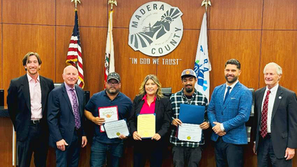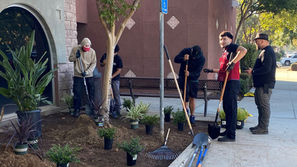Opinion: Alien circles in downtown?
- Jim Glynn
- Mar 5, 2022
- 4 min read
Some years from now, passengers in a low-flying airplane may report seeing “alien circles” right in downtown Madera. However, unlike the “crop circles” that are sometimes reported to exist in mid-West farmlands, the local phenomenon has a logical explanation. After years of prompting and procrastination, Caltrans (California Department of Transportation) is finally going to do something to improve State Route 145 through the City of Madera.
After multiple meetings with city officials and stakeholders, the state has produced “State Route 145 Pavement Project and Complete Streets,” under the direction of John Liu, Deputy Director, Caltrans District 6 Maintenance and Operations. The plan consists of a “South Segment” along 3,020 feet of South Madera Avenue, from Avenue 13 to the East Madera Underpass Bridge; a “Downtown Segment,” including major modifications from E Street to Lake Street; and a “North Segment” from Lake Street to an area a bit short of the High-Speed Rail (HSR) underpass.
Both the South Segment and the North Segment seem to involve mostly the construction of sidewalks. However, the Downtown Segment involves creative restructuring of the highway, itself. Construction cost for the entire project is estimated at $13.4 million, which includes $4 million for “complete streets enhancements.”
Project overview
According to the “Project Overview,” the scope of the plan includes removal and replacement of pavement; installation and upgrading of curb ramps; installation of bicycle facilities, bike parking, and bulb-outs; installation of transit stops; and upgrading of traffic signals. The goal, apparently, is to bring the section of Madera that is being considered into accordance with the Director’s Policy 37 (12/7/2021), otherwise known as “complete streets.”
In part, the policy reads: “The California Department of Transportation (Caltrans) recognizes that walking, biking, transit, and passenger rail are integral to our vision of delivering a brighter future for all through a world-class transportation network.” However, passenger rail is not mentioned as part of the project which is scheduled to begin in fall, 2024. The statement continues: “Accordingly, in locations with current and/or future pedestrian, bicycle, or transit needs, all transportation projects funded or overseen by Caltrans will provide comfortable, convenient, and connected compete streets facilities for people walking, biking, and taking transit or passenger rail unless an exception is documented and approved.”
With the exception of a more elaborate plan for downtown Madera, the project seems to consist mainly of improving sidewalks for walking and the creation of bike paths for bicycling from Avenue 13 along South Madera Avenue, continuing along Gateway Drive, and concluding along East Yosemite Avenue (SR 145) to the vicinity of the HSR underpass.
Downtown Madera
The “Downtown Segment” of the project outlines the plans for renovation beginning at the east corners of Yosemite Avenue and E Street and includes Highway 145 to the east corners of Lake Street. The current four traffic lanes will be reduced to two lanes. Throughout the six-block stretch, existing curbside parking will be retained, with a significant modification on the south side of Yosemite Avenue between D Street and C Street. Along that one-block, slant-in parking spaces will be marked. However, the slant-in’s are opposite the flow of traffic, meaning that drivers wishing to park their cars in that area will have to stop and back into the parking spot. This will make for an easier egress into flowing traffic, but — in my opinion — that could be troublesome when a car comes to a complete stop and then backs up on a single eastbound lane of a state highway.
Along this six-block stretch, traffic lanes will be narrowed to 11 feet to allow for the addition of Class 2 bicycle lanes. According to Appendix B of the Caltrans Design Standards, Class 2 bicycle lanes are one-way lanes in the same direction that traffic flows. Where parking stalls are marked (as they will be in Downtown Madera), bicycle lanes are to be 5 feet wide, marked with a 4-inch stripe. A Class 2 bicycle lane supposedly allows room for a bicycle to pass a parked car safely, even if a traffic-side door is open.
The plan also provides for the installation of 18 bulb-outs along the six-block strip. According to Caltrans Design Standards, bulb-outs are “curb extensions (that) may be installed as part of a traffic calming project….” On the schematic, they look like semi-circular bulges of pavement that jut out into the Yosemite traffic pattern. The effect is to shorten the distance for walkers who need to cross Yosemite Avenue. Bulb-outs will be placed on all four corners of A Street, B Street, C Street, and D Street. The east corners of E Street will be the locations for the 17th and 18th bulb-outs.
The “Lake Street Option” shows that traffic signals will be retained and there will be two through lanes in each direction. However, these lanes will also be narrowed to 11 feet in order to add the 5-foot-wide bicycle lanes. At this point, it should become clear that Caltrans would like to see a future California that relies less on the automobile and more on walking, bicycling, and using public transportation, including light rail.
Traffic circles
The most innovative part of the Caltrans plan is the installation of traffic circles at the intersections of C Street and D Street with Yosemite Avenue. Traffic circles, also known as roundabouts, are circular intersections in which road traffic is permitted to flow in one direction around a central island. Cars enter the circle from various streets and exit on various streets. According to Caltrans, compared to traffic signals and stop signs, modern traffic circles reduce the likelihood and severity of collisions by reducing traffic speeds and minimizing T-bone and head-on collisions.
Theoretically, although traffic moves slower, cars will enter and exit the downtown area more quickly because of the absence of traffic lights. The copy of the schematic for Madera’s traffic circles that I have seen does not show a central island in either roundabout. But I have an idea. Currently, cannabis distributors are jockeying for downtown locations for marijuana/CBD dispensaries. I think that the city could raise significant funds by erecting bleacher seats in the central islands and selling tickets (like at a ball park) to people who want to sit and watch drivers exit a pot shop and try to find their way through a traffic circle.
• • •
Jim Glynn is Professor Emeritus of Sociology. He may be contacted at j_glynn@att.net.


























Comments